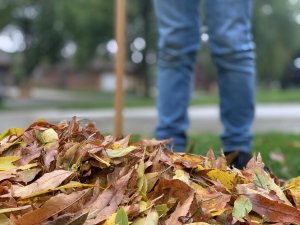
Work smarter not Harder!
Raking Leaves and Back Strain: How to Protect Your Spine This Fall
When the fall colors peak and the leaves start piling up, most people grab a rake and head outside. What starts as a simple chore, though, can easily turn into an afternoon of overexertion and next-day soreness. Raking may not seem physically demanding, but repetitive bending, twisting, and lifting can place tremendous stress on the muscles, ligaments, and joints of your back.
At O’Hara Family Chiropractic in Arlington Heights, Dr. Kevin O’Hara frequently helps patients who develop back strain after weekend yard work. The good news? Most of these injuries are preventable with the right techniques and a few simple changes in approach.
Why Raking Leaves Causes Back Strain
Raking seems harmless, but it engages multiple muscle groups in the back, shoulders, and core—often for long stretches without rest. The most common causes of back strain include:
-
Repetitive Motion: The same twisting and pulling movements fatigue muscles quickly.
-
Improper Posture: Hunching or bending at the waist places strain on spinal joints and discs.
-
Overreaching: Extending the arms and twisting simultaneously stresses the lower back.
-
Heavy Loads: Wet leaves weigh more than you think. Lifting or dragging full bags can overwork small stabilizing muscles.
-
Cold Muscles: Starting yard work without warming up increases the risk of strains and spasms.
Even people in good shape can experience soreness after hours of raking if their posture or movement mechanics are off.
Recognizing a Back Strain
Typical symptoms of a mild to moderate strain include:
-
Tightness or stiffness in the lower back
-
Sharp or aching pain during movement
-
Muscle spasms or tenderness along the spine
-
Pain that radiates slightly into the hips or buttocks
These symptoms often appear within hours and can worsen overnight. While most mild strains improve with rest and conservative care, persistent or severe pain may indicate deeper structural involvement.
Immediate Steps After You Strain Your Back
If your back tightens or “locks up” after yard work, don’t try to push through it. Follow these simple steps:
-
Stop and Rest: Continuing to rake or lift will worsen the inflammation.
-
Apply Ice: Use ice for 15-20 minutes several times a day to reduce swelling and inflammation.
-
Avoid Heat: Heat may feel good initially but can increase inflammation and delay recovery.
-
Gentle Movement: Light walking or slow stretching keeps blood flowing and prevents stiffness.
-
Take an Anti-Inflammatory (If You Tolerate It):
And yes, I’ll admit it—I take ibuprofen. I don’t like pain any more than you do. I know that’s not always popular in the chiropractic community, but I don’t care. If you can take it safely and it helps, take it. It works on inflammation—and if it hurts, you’re inflamed.
How Chiropractic Care Helps Back Strain
When inflammation subsides, chiropractic care can restore mobility, alignment, and balance to the spine. Dr. Kevin O’Hara focuses on:
-
Spinal Adjustments: Restore normal joint motion, relieve pressure, and reduce nerve irritation.
-
Soft Tissue Therapy: Loosens tight muscles and breaks up inflammation around strained areas.
-
Postural Evaluation: Identifies movement habits that caused the strain.
-
Rehabilitation Exercises: Strengthens the muscles that support spinal health and stability.
Chiropractic care doesn’t just address the pain—it targets the cause of the strain so you can heal properly and prevent recurrence.
How to Prevent Back Strain While Raking
-
Warm Up First: Light stretching or a short walk prepares muscles for activity.
-
Use the Right Rake: Choose a lightweight rake with an adjustable handle to reduce bending.
-
Maintain Good Posture: Keep your back straight and hinge at your hips, not your waist.
-
Switch Sides Often: Alternate your lead hand to avoid overuse on one side.
-
Don’t Overreach: Keep the rake close to your body and take small sections at a time.
-
Lift Smart: Bend your knees, keep your back straight, and avoid twisting while lifting bags.
-
Take Breaks: Every 10-15 minutes, stand upright and stretch backward to reverse the raking posture.
-
Stay Hydrated: Muscles work better and recover faster when properly hydrated.
These habits can drastically reduce the strain your spine endures during yard work.
Recovery Tips for a Sore Back
If soreness sets in later that evening or the next day, focus on recovery:
-
Ice the area again to keep inflammation low.
-
Gentle stretching (hamstrings, hips, and lower back) promotes flexibility.
-
Light movement such as walking aids circulation.
-
Avoid prolonged sitting, which can tighten lower back muscles further.
-
Schedule a chiropractic evaluation if pain lasts more than a few days.
Chiropractic adjustments can restore movement and ease pressure, helping your back recover faster and function more efficiently.
Final Thoughts
Raking leaves might be a fall tradition, but back pain doesn’t have to be part of it. With proper body mechanics, pacing, and chiropractic care, you can keep your spine healthy while tackling yard work.
At O’Hara Family Chiropractic in Arlington Heights, Dr. Kevin O’Hara helps patients recover from back strain, prevent future injuries, and enjoy a more active lifestyle without discomfort.
Don’t let fall clean-up lead to a fall-down. If your back feels tight or sore after raking, schedule a visit today—we’ll help you get aligned, balanced, and ready for the next pile of leaves.
